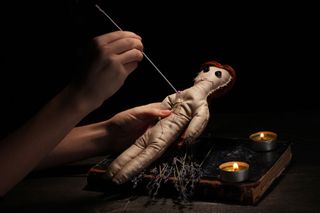Voodoo: Facts About Misunderstood Religion

Voodoo is a sensationalized pop-culture caricature of voudon, an Afro-Caribbean religion that originated in Haiti, though followers can be found in Jamaica, the Dominican Republic, Brazil, the United States and elsewhere. It has very little to do with so-called voodoo dolls or zombies.
Voudon refers to "a whole assortment of cultural elements: personal creeds and practices, including an elaborate system of folk medical practices; a system of ethics transmitted across generations [including] proverbs, stories, songs, and folklore... voudon is more than belief; it is a way of life," wrote Leslie Desmangles, a Haitian professor at Hartford's Trinity College in "The Encyclopedia of the Paranormal" (Prometheus Books, 1996).
Voudon teaches belief in a supreme being called Bondye, an unknowable and uninvolved creator god. Voudon believers worship many spirits (called loa), each one of whom is responsible for a specific domain or part of life. So, for example, if you are a farmer you might give praise and offerings to the spirit of agriculture; if you are suffering from unrequited love, you would praise or leave offerings for Erzulie Freda, the spirit of love, and so on. In addition to helping (or impeding) human affairs, loa can also manifest themselves by possessing the bodies of their worshipers.
Followers of voudon also believe in a universal energy and a soul that can leave the body during dreams and spirit possession. In Christian theology, spiritual possession is usually considered to be an act of evil, either Satan or some demonic entity trying to enter an unwilling human vessel. In voudon, however, possession by loa is desired. In a ceremony guided by a priest or priestess, this possession is considered a valuable, first-hand spiritual experience and connection with the spirit world.
History of voudon
Voudon originated with slaves who combined elements of their West African traditions and beliefs with the Roman Catholicism imposed upon them by their masters in a process called syncretism. A 1685 law forbade the practice of African religions and required all masters to Christianize their slaves within eight days of their arrival. Slavery was condoned by the Catholic Church as a tool for converting Africans to morally upright Christians. Slaves forced to adopt Catholic rituals thus gave them double meanings, and in the process many of their spirits became associated with Christian saints.
Furthermore, Desmangles notes, "Many of the African spirits were adapted to their new milieu in the New World. Ogun, for instance, the Nigerian spirit of ironsmiths, hunting and warfare took on a new persona... He became Ogou, the military leader who has led phalanxes into battle against oppression. In Haiti today, Ogou inspires many political revolutions that oust undesirable oppressive regimes."
Though Haitian slavery ended in the early 1800s, followers of voudon were often persecuted by authorities who demonized their religion. An 1889 book titled "Hayti, or the Black Republic" (Filiquarian, 2012) falsely attributed human sacrifices, cannibalism and other atrocities to voudon, further spreading fear of the religion. Many fundamentalist Christians still regard voudon and voodoo with suspicion, associating it with the occult, black magic and Satanism. Even today "voodoo" is often used as an adjective to describe something that is unknowable, mysterious or simply unworkable (for example, in 1980 George H.W. Bush famously disparaged Ronald Reagan's monetary policies as "voodoo economics").
Voodoo and zombies
The more sensational aspects of voudon, such as belief in zombies and animal sacrifice, have provided fodder for countless television shows and movies in the form of voodoo. Zombies are an especially good example of how a religious element can be taken out of context and become a global phenomenon.
According to the Oxford English Dictionary, the word "zombie" first appeared in English around 1810 when historian Robert Southey mentioned it in his book "History of Brazil." But this "zombi" was not the familiar brain-eating manlike monster but instead, like many voudon loa, a West African deity. The word later came to suggest the vital, human force leaving the shell of a body, and ultimately a creature human in form but lacking self-awareness, intelligence and a soul.
The original Haitian zombies were not villains but victims. Haitian zombies were said to be people brought back from the dead (and sometimes controlled) through magical means by priests called bokors. Sometimes, the zombification was done as punishment (striking fear in those who believed that they could be abused even after death), but often the zombies were said to have been used as slave labor on the island's farms and sugarcane plantations (though no evidence of the zombie-filled farms was ever found).
The voodoo popular in movies and fiction bears little resemblance to real voudon beliefs or practices. Voodoo has become a prominent feature of the New Orleans tourism industry, with countless shops, tours, exhibits and museums capitalizing on that city's historic (and, some experts say, tenuous) connection to voudon. Of course, stripping sacred objects and rituals out of their original context for commercial exploitation is nothing new: witness Chinese-made Native American dream catchers for sale at dollar stores.
In the end, voudon has a largely undeserved reputation as a sinister religion. Though some voudon rituals involve animal sacrifices, it is hardly unique; many other religious traditions involve animal bloodletting, including Christianity, Islam, Judaism and Hinduism. The irony is that voudon's best-known and most sensational features — including voodoo dolls and zombies — have little to do with its actual beliefs and practices.
Benjamin Radford is deputy editor of Skeptical Inquirer science magazine and author of six books, including "Tracking the Chupacabra" and "Scientific Paranormal Investigation: How to Solve Unexplained Mysteries." His website is www.BenjaminRadford.com.
Sign up for the Live Science daily newsletter now
Get the world’s most fascinating discoveries delivered straight to your inbox.

